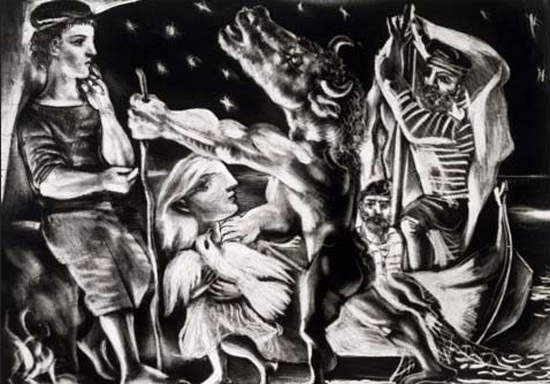If you find yourself discussing rock with someone who has sufficient musical culture and at the same time a certain intolerance of stars, you will most likely hear that David Bowie was not a genius because he did not invent anything. Because the glam rock that began with the character of Rainbow man is a reworking of the aesthetics and ideas of Marc Bolan and his Tyrannosaurus Rex. Because its intellectual, decadent, and gloomy appeal merely echoes that of the Velvet Underground. Because in fact, new wave is not his invention, but the consequence of his sojourn in the United States in the mid-1970s, where bands such as Television and Devo were already at work.
 |
| David Bowie in Chicago in 2002. Photo by Adam Bielawski |
Music, you know, is a terrain on which opinions clash with great uproar. And for a thousand reasons it is quite difficult to establish a definitive canon for constructing an impeccable rock history. But as difficult as such an operation is, on whether David Bowie ’s name should be included within this history, more or less everyone agrees. For in order to become part of the history of an art, it is not necessarily necessary to have invented something: if the history of art were reduced to a history of those who invented genres and forms of expression, perhaps it would be exhausted in a few pages. An artist’s merit also consists in being able to rework and develop the insights of others, perhaps to bring them to fruition, to achieve a result that the inventor of a genre had failed to achieve, or even more simply to present the original ideas in a form that is more innovative, or more palatable to the public and therefore more appreciated. On January 11, 2016, the day after the date of the passing of the fine British singer and musician, an interesting remembrance of Nile Rodgers, the undisputed symbol of disco music, appeared in the pages of the Guardian. Do you know such now-famous motifs as Le freak, c’est chic or Good times, these are the good times? Lo and behold, Chic and their two major hits are the creatures of Nile Rodgers, who had collaborated with David Bowie to produce the world-famous Let’s Dance, which in fact marked the multifaceted British artist’s debut in dance music.
Rodgers gave a decidedly fitting definition of Bowie: “David Bowie was the Picasso of rock’n’roll. Because I realized that he saw the world at the same time in the abstract and the way we see it.” Picasso, too, to put it a certain way, did not invent anything: he reworked Cézanne’s ideas by giving them an incredibly revolutionary form, and all thanks to his innate and extremely fertile creativity. Leo Stein spoke of an “infinite inventiveness” that always made his art alive: the same could be said of David Bowie. With one major difference: Picasso’s art could often be aggressive and violent; David Bowie’s, on the other hand, was elegant and stately. Although there was a precise moment when Bowie himself indulged in the brutal expressive force of Picasso’s art: in the 1995 video for The Hearts Filthy Lesson, set in a cluttered atelier, we see a group of artists shaping a disturbing sculpture, with the singer seeming to act as the grim master of ceremonies, a sort of Hermann Nitsch emended, however, by the fiercest truculence. For if an artist is genteel in his or her own right, he or she will continue to remain so even in the midst of bloodsheds and creative processes that resemble more like Dionysian rituals. The end result is a statue of a minotaur: a clear reference to Picasso, since the mythological character of the minotaur is central to the Spanish artist’s work. In Picasso, trivializing, the minotaur is a figure that embodies man’s most feral and base instincts: the artist’s alter ego, a being halfway between man and animal who loses himself in furious struggles and animalistic orgies, is finally overcome by his own brutality and is forced to be guided by a little girl toward a rebirth under the sign of true love. Bowie played Picasso’s minotaur in his concept album Outside (the same from which The Hearts Filthy Lessons is taken): here, the minotaur is a ruthless contemporary artist who kills a little girl to display her as a macabre work of art. Toward the end of the album, in the track I’m deranged, a dark, frenetic electronic ballad ripped apart here and there by piano inserts, the artist-minotaur begins to show signs of repentance and, as in Picasso, asks the little girl to guide him: I’m deranged / Cruise me, cruise me, cruise me baby (“I’m deranged / Guide me, guide me, guide me baby”).
 |
| The scene of the creation of the minotaur in the video of The Hearts Filthy Lesson |
 |
| Pablo Picasso, Minotaur Guided by a Little Girl (1934-1935; aquatint; Santa Barbara, Santa Barbara Museum of Art) |
It is no mystery that Picasso was, for the singer, a luminous source of inspiration. Interviewed by journalist Neil Strauss, David Bowie reportedly said that “You can’t look at Picasso without being completely inspired. He was always playing with his mind and his reactions to life, and he was always innovative and genuine at the same time. I think it’s a consequence of always being amazed by what the world is capable of.” Perhaps partly because of this fondness for Picasso, David Bowie in 2003 decided to come up with a reinterpretation of the joking song, simply titled Pablo Picasso and written in 1972 by Jonathan Richman of Modern Lovers, which presented the Spanish painter as an inveterate, successful womanizer: Well, some people try to pick up girls / And get called assholes / This never happened to Pablo Picasso (“Well, there are men who try to pick up girls, and get called assholes: this never happened to Pablo Picasso.”).
In 1994, when David Bowie began working with the art magazine Modern Painters (for the next four years his job was to interview great artists), he traveled to Rossinière, the small village in the Alps of French-speaking Switzerland, to converse with the great Balthus, who had chosen to reside in the Swiss mountains. An interview all the more valuable when we consider that Balthus was particularly reluctant to give himself to journalists. And Bowie, for his debut in Modern Painters thought, among other things, to propose to Balthus a parallel between Alberto Giacometti and Picasso. How elegant the former was (and a great draughtsman, Balthus was careful to point out), how playful the latter was. Balthus, speaking to Bowie, had ambiguously called Picasso “a skater.” The singer, on the other hand, continued to propose the same adjective for Picasso that he had already used on other occasions: childlike, difficult to render in Italian, because the childishness that Bowie attributed to Picasso was to be seen in a positive way. That is, Picasso had the faculty of approaching the world with the fervid imagination of a child, and of being able to grasp with almost childlike amazement all the suggestions that reality provided him.
 |
| Balthus and David Bowie (from Pinterest) |
Picasso’s versatility is the same that distinguishes David Bowie, an eclectic genius capable of filtering the most disparate cues and availing himself of important collaborations to create his own works of art. An artist capable of addressing a heterogeneous audience, ranging from the mournful acting of Please, Mr. Gravedigger to the commercial sounds of Let’s dance via the glamorous and lascivious rock of Suffragette City: just three episodes, and not even too symbolic, of a career that lasted about fifty years and therefore impossible to summarize in a few lines. Just as impossible to summarize are the artistic references that continually permeate his oeuvre: from the set designs for the Diamond Dogs tour inspired by George Grosz ’s paintings to the outfits used in 1979 for a performance on the American show Saturday Night Live, which were a direct derivation of those designed by Sonia Delaunay for Tristan Tzara’s Le coeur à gaz, not to mention the numerous references to Andy Warhol. David Bowie may have ridden the coattails of fashions, and he may have been fully embedded in the international star system, becoming in turn a gossip tabloid figure and an often trivialized pop icon, but he was able to create refined and cultured works that have consigned to the history of music his image as an abstract, charming, sophisticated and richly interested dandy, worthy of being remembered also because he was able to popularize genres otherwise reserved for circles of connoisseurs, influencing legions of artists, singers and musicians who repeatedly cited him among their points of reference.
Suggested listening: David Bowie, The prettiest star - T.Rex, Hot love - Velvet Underground, Venus in furs - Chic, Good times - David Bowie, Let’s dance - David Bowie, The hearts filthy lesson - David Bowie, I’m deranged - David Bowie, Pablo Picasso - David Bowie, Suffragette city
Warning: the translation into English of the original Italian article was created using automatic tools. We undertake to review all articles, but we do not guarantee the total absence of inaccuracies in the translation due to the program. You can find the original by clicking on the ITA button. If you find any mistake,please contact us.